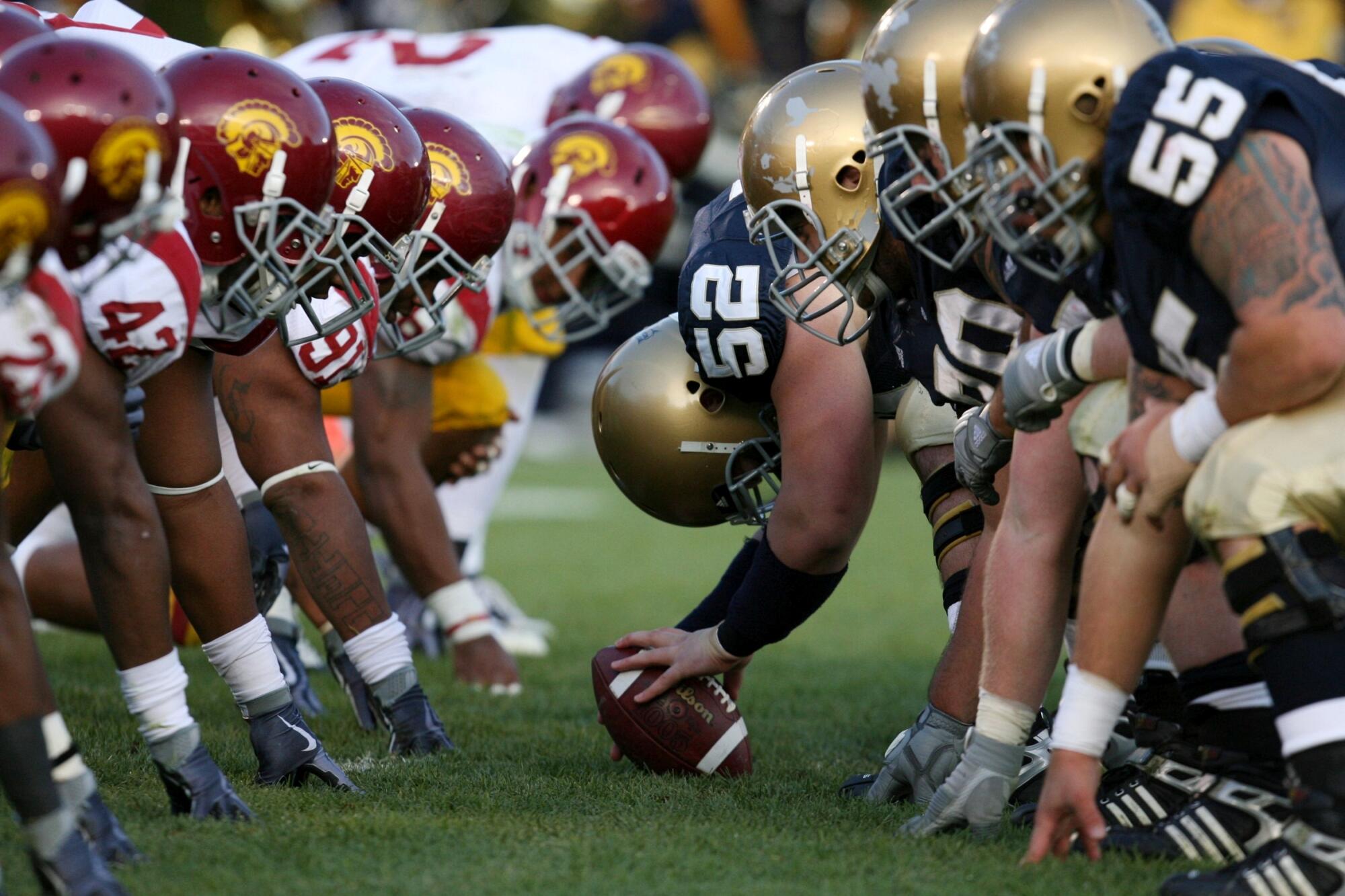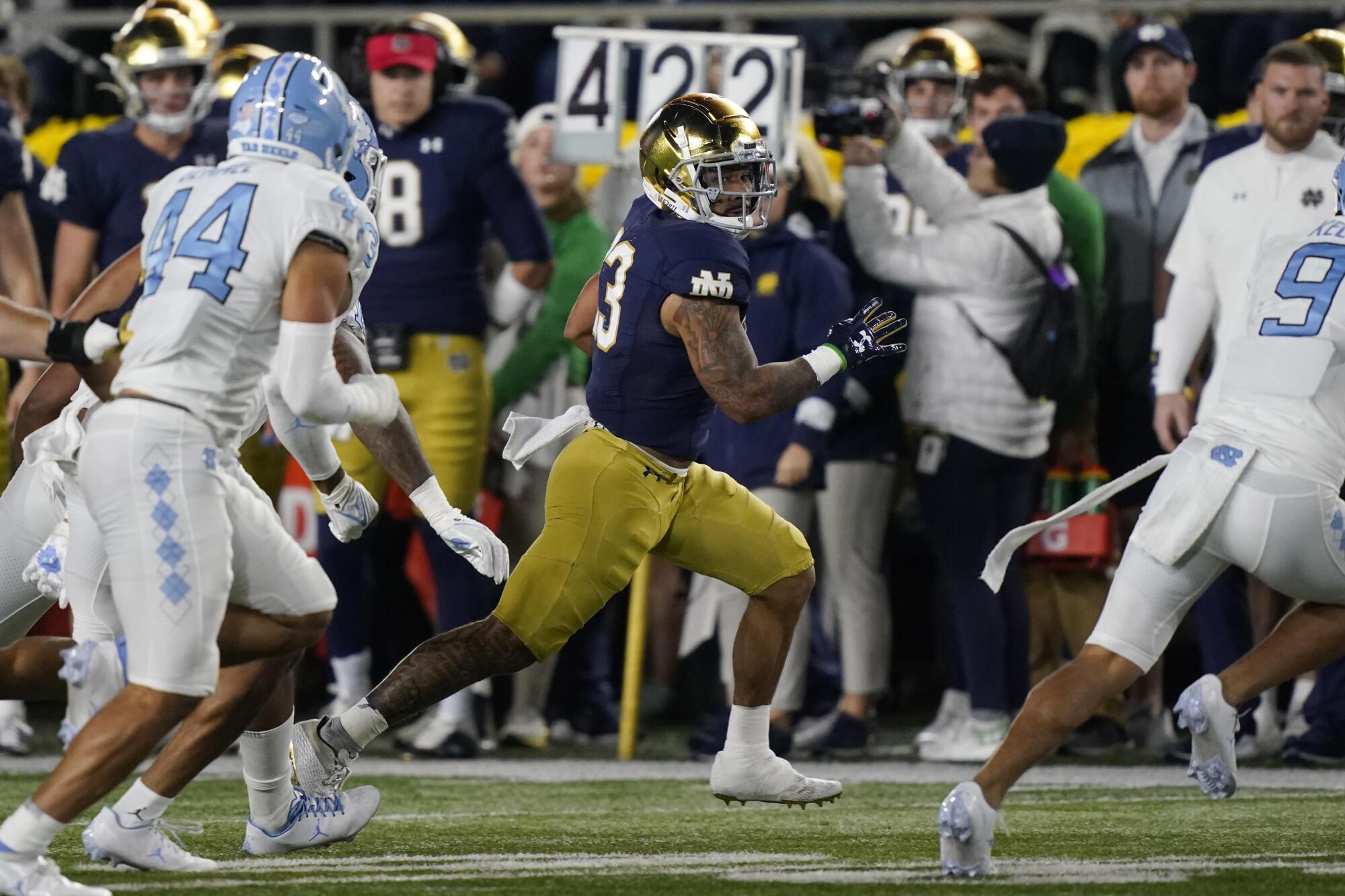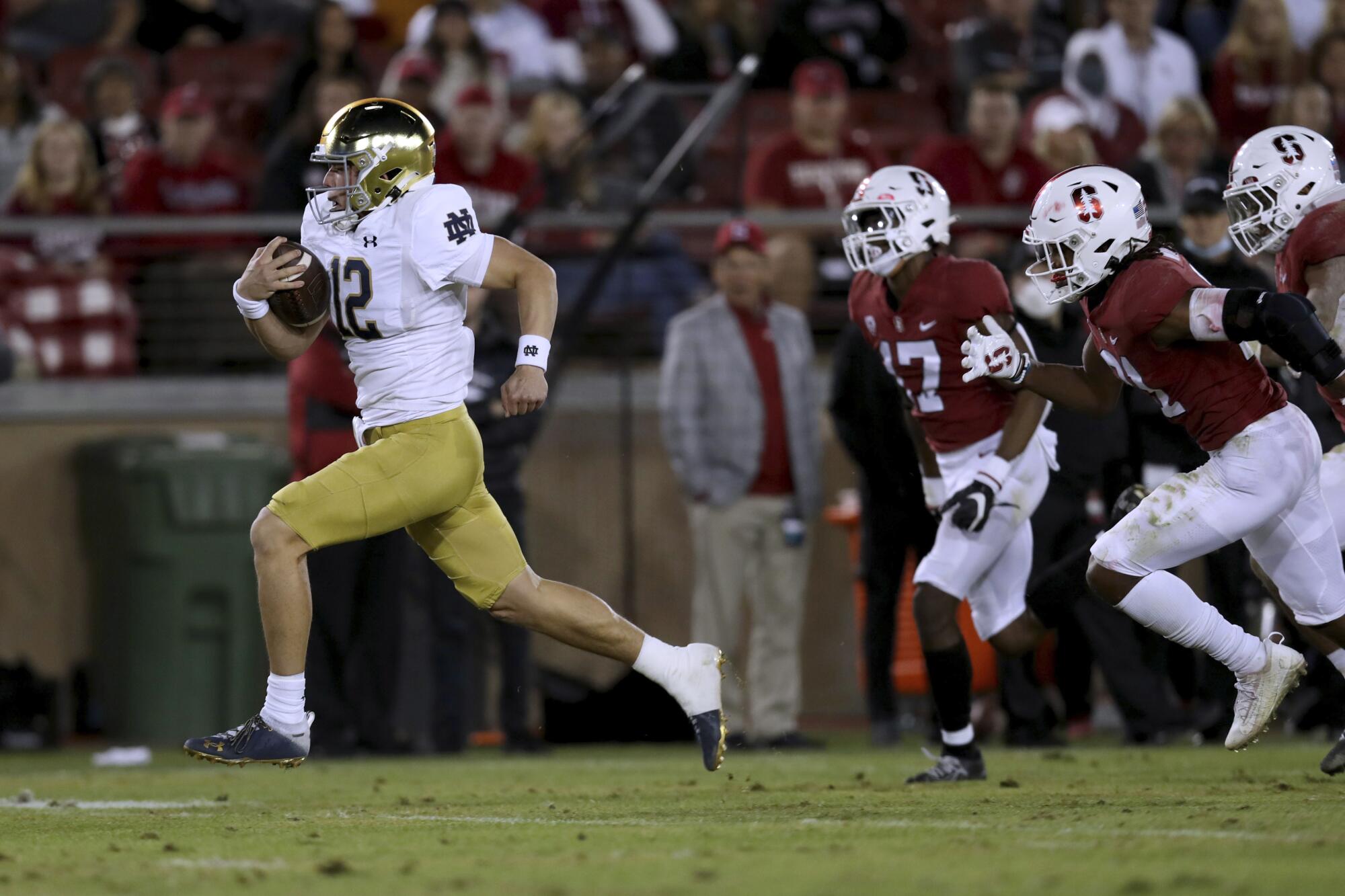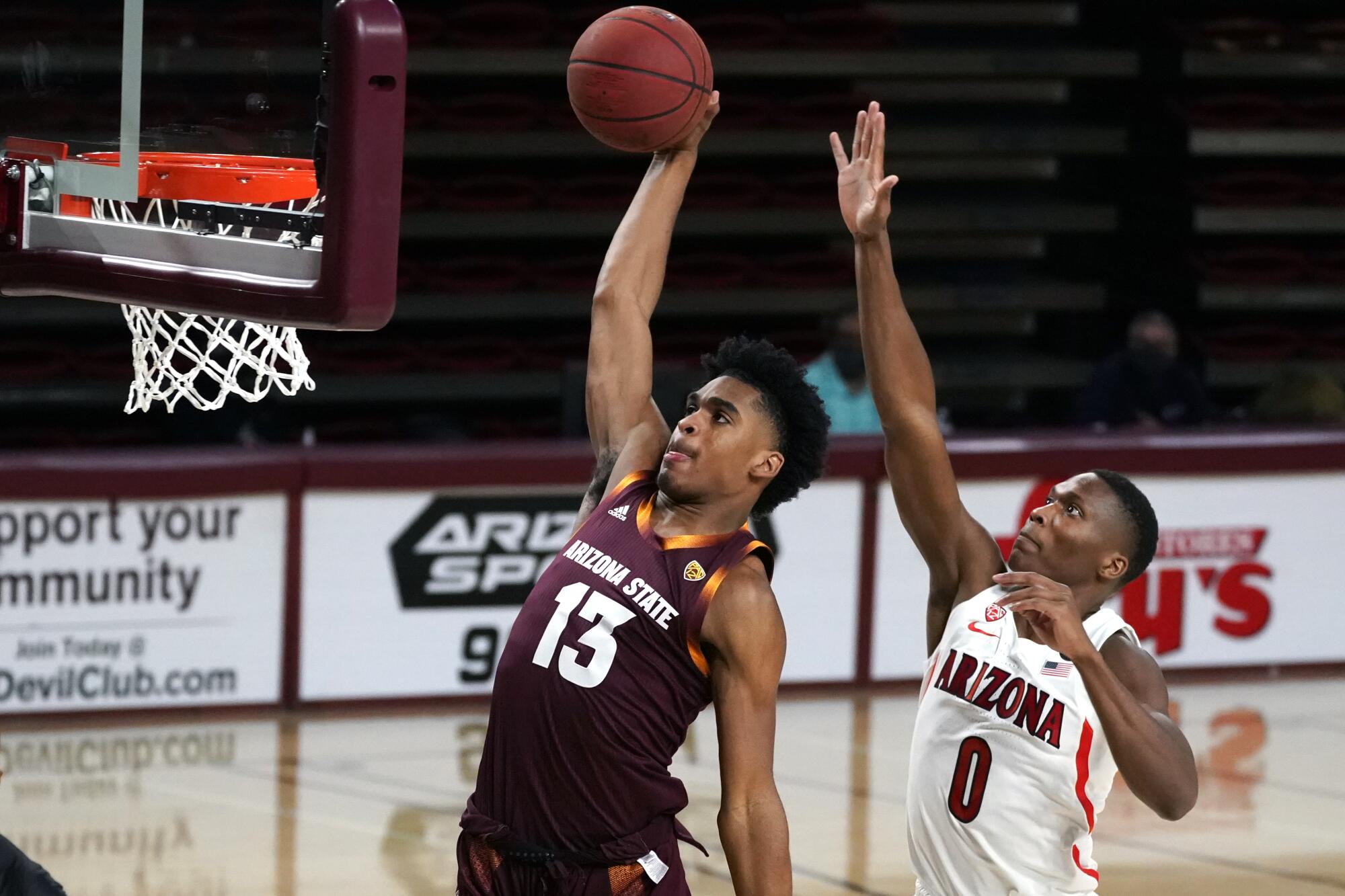
- Share via
It might feel like the move of USC and UCLA to the Big Ten Conference on Thursday was the start of another realignment wave, but in truth it was just the next crest — albeit a massive one that is still shaking college sports’ foundation — in the wave that began last July.
If Texas and Oklahoma didn’t ditch the Big 12 for the Southeastern Conference, it is hard to imagine USC and UCLA feeling as if they had no choice but to toss aside a century of Pac-12 Conference tradition in order to stay viable.
While the Trojans’ and Bruins’ escape from the uncertainty of the Pac-12 shouldn’t be viewed as a stand-alone action, it certainly can be argued this is the shift that fully finalizes the transition from a “Power Five” to a “Power Two.”
With players being paid, universities have to follow the money, and UCLA and USC are making a smart move by leaving the Pac-12 for the Big Ten Conference.
The SEC and the Big Ten are seceding from the rest of college sports. They have no peers and will continue to establish that. If you’re not in their club, you won’t matter, unless you’re Notre Dame, which is why everybody from Eugene, Ore., to Clemson, S.C., to Miami is going to be trying to find their way onto the ark in the next few years.
How exclusive will the Power Two be now that they’re both at 16 schools? What is the Big Ten’s (and Fox’s) next move? How will the SEC (and ESPN) respond? Is the Pac-12 doomed? Let’s dive into the latest realignment madness.
The Notre Dame question
Multiple sources told The Times that the Big Ten will not be adding another Pac-12 school at this time. It would have been a natural assumption that a pairing of Oregon and Washington would follow their longtime conference brethren, but that is off the Big Ten’s board for now. Maybe the preferences of USC and UCLA — Fox’s priority because of the the brands and the Los Angeles market — have something to do with that?.
That means Notre Dame will be the next driver in any movement with the Big Ten, which has long coveted the Fighting Irish for all of the obvious reasons — brand power, football tradition, academic reputation and location.
If Notre Dame rebuffs the Big Ten and elects to stay independent in football and play other sports in the Atlantic Coast Conference, it’s possible the Big Ten takes a pause and continues to consider the remaining Pac-12 brands and ACC brands that fit the Big Ten model, such as North Carolina, Virginia and Georgia Tech.

But, make no mistake, Notre Dame is the ultimate get and the Big Ten has more to offer the Irish than ever before — a chance to share a conference with historic rival USC along with other rivals Michigan, Purdue and Michigan State; a chance to shoot its take from media rights into a new stratosphere; and a chance to assure itself of a rightful place at the power brokers’ table going forward.
Notre Dame has to be getting the itch. If it isn’t, its longtime TV partner NBC will have good reason to nudge it into considering the Big Ten’s offer. Reports are that NBC wants a Big Ten game as part of the conference’s new media rights package.
If you remember that TV is dictating all of these dominoes, it’s much easier to wrap your head around Notre Dame saying yes to the Big Ten.
Who would join Notre Dame?
While sources are convinced that the Big Ten is done poaching the Pac-12, that calculus could change if the Fighting Irish are down to join up as a 17th member.
Stanford will become a much more appealing option than it is at this moment because the Cardinal represent another annual Notre Dame opponent that the Irish would like to continue playing.
If you put yourself inside the heads of snotty Big Ten presidents and chancellors, Stanford just has a different aura about it institutionally than Oregon and Washington. All higher education types want to be associated with Stanford. While the football and men’s basketball teams are down currently, the Big Ten would be able to benefit from Stanford’s excellence across all sports.

It’s a jump to say that adding Stanford brings the Big Ten the Bay Area TV market in full, but being located in a highly populated region also can’t hurt its case.
The Cardinal would be a more palatable West Coast partner for USC and UCLA than the Ducks and Huskies. Both L.A. schools are sick of Oregon with its Nike flash coming into Southern California and stealing top talent, and USC’s and UCLA’s move to the Big Ten has wounded the Ducks.
What can the Pac-12 do?
It can’t be overstated how debilitating losing USC, UCLA and the L.A. market is for the Pac-12. There’s a reason that Apple reportedly jumped back into the mix for a slice of the Big Ten’s rights package after the news. A Pac-12 without the Trojans and Bruins will struggle to gain much traction at the bargaining table as commissioner George Kliavkoff negotiates the league’s next media rights agreements in the coming year.
The Pac-12 announced Friday it will be actively looking to expand. Yet who would join besides schools from the Mountain West?
The financial boon awaiting UCLA with the Big Ten, coupled with its athletes playing on a more visible stage, spurred the decision to leave the Pac-12.
The Pac-12 likely could have had its pick of the remaining Big 12 schools last summer. Oklahoma State, Texas Tech, Kansas and company all felt spurned by the Pac-12’s lack of interest in what they had to offer. Think they’re going to come out here now, knowing that the remaining big-name programs are going to be desperately pitching themselves to the Big Ten and probably the SEC?
The Big 12 actually has a more stable situation than the Pac-12 now and probably would have some success raiding some of the Pac-12.
At least the schools in the Big 12 (which added Brigham Young, Central Florida, Cincinnati and Houston) already know that the Big Ten and SEC have minimal interest and can act strategically to build the third- or fourth-best conference going forward.
Would the Big 12 now be attractive to Arizona and Arizona State? We’ll find out soon enough.

SEC eyeing ACC?
Thursday was not a great day for the SEC and ESPN. Are they scared of the Big Ten and Fox now? Probably not. Any plans for further expansion probably will be dusted off if they haven’t been already.
Florida State, Clemson, Miami and Virginia Tech are all enticing football brands. Pairing North Carolina and Duke with Kentucky would immediately make the SEC the premier basketball conference.
The ACC’s media rights deal with ESPN expires in 2036. The schools received distributions of $36.1 million for the 2020-21 fiscal year, and, given what the Big Ten and SEC are about to bring in for their schools, that’s not going to be enough to keep their top brands happy.
Since ESPN owns the rights for the SEC and ACC, the network should have ultimate say.
More to Read
Go beyond the scoreboard
Get the latest on L.A.'s teams in the daily Sports Report newsletter.
You may occasionally receive promotional content from the Los Angeles Times.













